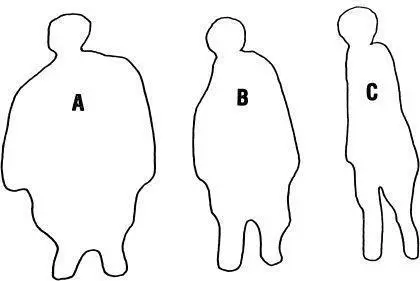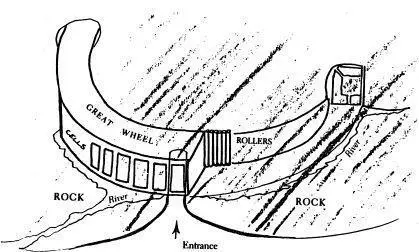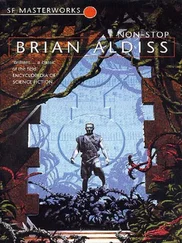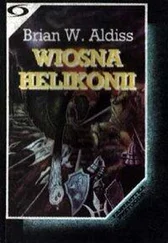The helico virus is endemic twice in a Great Year, firstly approximately 600 E years after apastron. It then rages for many small years, coincidental with improving climatic conditions and increased solar energy. Its second appearance is during a decline into wintery conditions, some 1800 E years after apastron.
At its every visitation, the virus brings widespread death. It strikes at the hypothalamus, causing encephalitis (inflammation of the brain) and delirium. Its manifestations at this stage resemble meningitis. Populations are usually reduced to about half. Survivors take on altered form, gaining (in autumn) fifty per cent of normal body weight, as fatty tissue is built up. This phase is marked by unquenchable bulimia: their own children, faeces, asokins — sufferers will seize on and eat anything living. The survivors of the spring epidemic shed a corresponding amount of weight, marked by anorexia and self-starvation.

Figure 4 . Human form changes throughout Great Year shown in diagram
ASurvivor of Fat Death towards Winter
BMedian figure
CSurvivor of Bone Fever in Spring
In the course of several generations, surviving populations shed the extremes of their thin or heavyweight forms, tending to return to a more average constitution. In so doing, they also lose immunity to the virus.
It will be seen that this terrible scourge has a positive aspect. It forms part of a natural process, ensuring human survival throughout the climatic changes wrought by cosmic upheaval.
In more primitive times, the two phases of the helico pandemic were not recognised as springing from one and the same cause. They were known (in autumn) as the Fat Death, and (in spring) as Bone Fever. By the period covered by Book 3 (‘Winter’), the doctor Toress Lahl has gained a clear understanding of Fat Death — and of its survival rate. A great chain of eclipses occurs at this period, making Bone Fever outbreaks even more terrifying. A total of twenty eclipses takes place between 630 and 658 E years AA. [3] Eclipses occur in the following manner. The orbits of Helliconia and her sister planets lie at a 10° inclination to the orbit of Batalix and Freyr about each other. Helliconia’s orbit crosses the greater orbital plane at two points. Joining these two points is the line of the nodes. When the line of the nodes passes through Freyr, so that Helliconia, Batalix, and Freyr are aligned, then eclipses of the greater light will occur. A lesser eclipse cycle occurs on the other side of periastron, lasting for 9.45 years. In accordance with Kepler’s laws, Batalix speeds up when closer to Freyr. It therefore takes less time to move from the Fat Death eclipses to the post-periastron position than from the post-periastron position to the Fat Death position in 630 E yrs AA. So the second eclipse series commences in the year 1424 E yrs AA.
VIRUS CARRIER
The carrier of the helico virus is a species of arthropoda or tick. This vector transfers readily from phagors to humans. Phagors are immune to the virus. The human habit of using phagors as slaves or soldiers during the Great Summer and onwards ensures the survival of both tick and virus (even when the latter is latent) among human populations.
The helico virus is a reminder (for those who can understand) of the connection between the present deadly hostility of phagor and humanity and a distant past when the two species were commensal.

Figure 5 . Diagram of human biomass governed by Helico virus.
Terrible though the disease is, human survival is largely dependent upon the violent weight / shape transformation which it effects. Thus, if the humans succeed in eliminating their enemies, they cause their own undoing.
Or so it seems. If the nations of Summer ceased to war among themselves, if they could then defeat the phagor legions, if they could maintain a selected number in the equivalent of zoological gardens, then humanity could break free from its present limitations. But these are large Ifs….
Kharnabhar is a small town in a remote region of Sibornal. The town has grown up about a remarkable monument, the Great Wheel of Kharnabhar. Previously a sacred site, it now houses criminal elements.
The fame of the Great Wheel is universal. When SartoriIrvrash arrives in Ashkitosh (Bk. 2, xi), he sees a tapestry bearing an allegorical depiction of the Wheel. ‘Upon a scarlet background, a great wheel [was] being rowed through the heavens by oarsmen in cerulean garments, each smiling blissfully, towards an astonishing maternal figure from whose mouth, nostrils, and breasts sprang the stars in the scarlet sky.’
The main and almost only route to Kharnabhar is from the port of Rivenjk, on the Climent Sea coast, northwards through the mountains of the Shivenink Chain. The distance is about 2400 miles, equivalent to a journey from Gibraltar to the north of Norway.
The Great Wheel
The Wheel is a granite ring, carved inside a granite mountain of the Chain. It revolves within Mount Kharnabhar, only one small segment being accessible from outside the mountain. The Architects long ago created the Wheel, encoding with its dimensions the external world, in a bid for astrological symmetry. ‘As Above, so below.’ The holy men who first occupied the Wheel intended it as an instrument by which to propel their world across the heavens, out of Winter and into the welcoming light and warmth of Freyr.
Originally, the Great Wheel was dedicated to God the Azoiaxic (meaning ‘something which revolves beyond life’ — later interpreted to mean ‘one who existed before life and round whom all life revolves’).
Penned within the confines of the mountain, the Wheel is inclined at 5° to the horizontal. It rotates above a floor inclined at 4°. This slight difference permits the river flowing round the base of the Wheel to carry mud beneath it, acting as lubricant.
Three-walled cells like alcoves line the outer surface of the ring. The ring is kept in slow movement, day by day. The immovable fourth wall is not part of the Wheel, although it closes off all the cells; it consists of solid unmoving rock, Mt Kharnabhar itself. Into the rock is inset lengths of chain, stapled firmly into the wall. These chains hang at 125 cm intervals.
With these chains, prisoners in the one thousand and eighty-five cells can haul themselves into and through the dark night of granite. When priests’ trumpets sound throughout, all prisoners must pull in unison on their chains. So the Wheel is shifted in its journey through rock or — as some still claim — through the heavens.
Some technical data
| Wheel diameter |
1825 metres (Number of Small Years in one Great Year) |
| thickness |
13.19 m (1319 being the year of Freyr-set or Myrkwyr at latitude of Kharnabhar, counting from apastron) |
| height |
6.60 m (12 times 55, the latitude of the Wheel) |
| Cell height |
240 cm (= the 6 wks of 1 tenner × the 40 mins of 1 hr) |
| width |
250 cm (+ the 10 tenners of 1 yr × the hrs in a day) |
| depth |
480 cm (= no. of days in Small Year) |
| Wall thickness between cells |
0.64159 m (+ cell width gives value of pi ) |

Figure 6 . Diagram of the Great Wheel within the granite of Mt. Kharnabhar. (Bambeck protection).
After ten years, the Wheel has been tugged by a captive back to the point at which he started his imprisonment. A revolution has been completed. On that final day, one prisoner finds daylight instead of stone for the fourth wall of his cell, and may make his exit to freedom; in the cell leading his, another man will be entering for his first day of the ten-year journey into and through the rock.
Читать дальше











